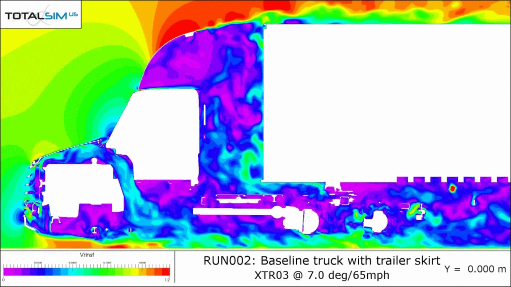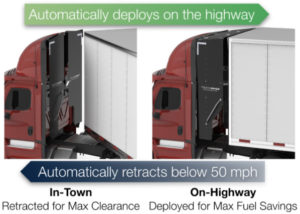A Quick Guide to Improving Tractor Trailer Aerodynamics
Did you know that improving trailer aerodynamics can significantly impact drag and fuel efficiency?
Aerodynamic drag is responsible for 65% of the energy used while pulling a trailer. That's why more fleets are turning to products like trailer aerodynamic products to help reduce drag and save money on fuel costs.
But what are trailer aerodynamics, exactly?
And which product is right for your fleet?
Answering these questions requires understanding the effects of aerodynamic drag on tractor-trailers and the different types of products available to reduce it.
What Are Trailer Aerodynamics?
Trailer aerodynamics refers to the study of how air flows around and over a trailer.
When a truck moves, air resistance (or drag) slows it down and uses up fuel. Reducing drag can lower fuel consumption by up to 12%. This would save more than $10 billion in diesel fuel per year.
The Main Points of Drag on Tractor Trailers
To understand how to reduce drag, it's essential to know where it comes from.
There are three main points of drag on tractor-trailers:
- Back of the trailer near the doors: When air circulates around a trailer, it forms a vortex behind the rear door, causing a significant decrease in air pressure.
- Front of the trailer near the gap: One of the worst low-pressure areas on a truck is the gap between the cabin and trailer.
- Trailer undercarriage: When air passes under the bottom of the trailer where the wheels are, it causes drag and decreases fuel economy.
Addressing these areas can significantly improve trailer aerodynamics.

Products and Devices to Reduce Tractor-Trailer Drag
Aerodynamic devices are effective at reducing drag and improving fuel efficiency.
And the faster the speed, the more efficient they become. Many products and devices on the market can help reduce drag.
- Trailer fairings: The trailer fairings (or skirts) keep the wind from blowing under the trailer and into the bogie. They work best when they start from the landing gear and end at the front face of the front trailer axle, close to the ground.
- Trailer tails: Trailer tails are devices mounted at the back of trailers to alter the airflow as it leaves the trailing edge of a truck's side and top surfaces. While they can boost vehicle fuel efficiency by up to 6%, the sale of trailer tails ceased in 2020.
- Wheel covers and mud flaps: Wheel covers are devices inserted into the wheel that help direct airflow around the tires. Mudflaps are installed behind the wheels and help deflect air away from the undercarriage.
When choosing an aerodynamic device, it's important to remember that many will complement each other. For example, using trailer tails with wheel covers further reduces drag.
Of course, fleet owners must consider the unique needs of their operation when choosing products.
Trailers Are Only Part of the Equation
While trailer aerodynamics are important, they account for only some of the drag that impacts fuel efficiency.
The front tractor section also accounts for a significant amount of drag (about 25%). To address this, some truck manufacturers are exploring a more aerodynamic design for the front of the truck.
Some solutions include adding pedestal door mirrors and sloped-front windshields.
The gap between the cab and trailer also accounts for about 25% of the overall drag. High-speed air rushing in causes a low-pressure area which then drags on the tractor and decreases fuel economy.
Closing the gap would result in a decrease in airspeed and less turbulence downstream. Increased pressure at the back of the cab would decrease overall drag, especially where crosswinds are strong.
For fleet owners, this could mean a significant decrease in fuel consumption and savings amounting to millions of dollars each year.
Learn how Ryder Systems saved 4.1% on fuel with TruckWings.
Improve Trailer Aerodynamics and Fuel Efficiency
Cutting emissions and fuel costs is a high priority for trucking fleets.
That's why many fleet owners are investing in trailer aerodynamic devices.
There are two types of trailer aerodynamic devices:
- Hardware-only devices that require driver interaction.
- Smart products that are automated and require no driver interaction.
TruckWings and TrailerTails are two devices that are sometimes confused, but there are key differences between them. TrailerTail (discontinued) was a hardware-only device installed on the back of the trailer that required the driver to close it manually. TruckWings is the only fully automated, tractor-mounted device that works without interaction, allowing for the best driver experience.

By automatically closing the gap between the cab and trailer, the device:
- Improves stability
- Increases fuel efficiency
- Reduces drag
TruckWings also:
- Provides potential fuel savings of 4-6%, reaching an ROI in under 200,000 miles with zero operational downtime
- Operates in two positions — closed when the truck travels fast on an open highway and open when going slow or making turns
- Uses smart sensors to track carbon and fuel savings
- Provides uptime reporting
If you want to improve fuel efficiency, contact us to learn more about TruckWings.
FAQ
How do I reduce drag on my truck trailer?
There are several ways to reduce drag on your trailer, including:
- Adding trailer fairings (or trailer skirts) to keep the wind from blowing under the trailer and into the bogie.
- Installing mudflaps and wheel covers to help direct airflow around the tires.
- Adding a trailer tail to alter the airflow as it leaves the trailing edge of a truck's side and top surfaces.
Why do truck trailers have wings?
Wings help keep the trailer more stable and improve fuel economy.
Do truck wings work?
Yes, they are an effective way to reduce drag and fuel costs. In fact, TruckWings provides potential fuel savings of 3-6% mpg with 12-18 months ROI resulting in millions of dollars saved per fleet.


